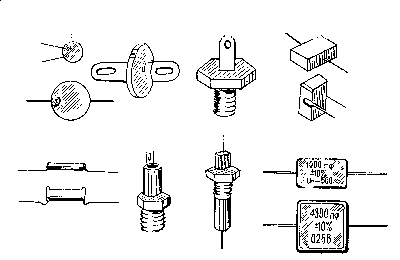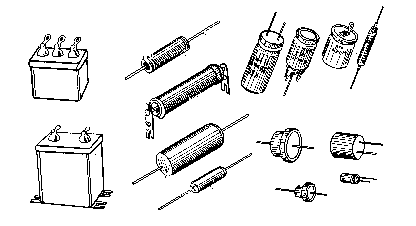|
home
bases
elements
examples of accounts
amateur technology
radio reception
for houses and life
the coherent equipment
TV
the help data
measurements
the review of the radio amateur circuits in magazines
a feedback
|
|
Acquaintance
from radio by details
What only details will not be necessary for manufacturing offered
designs! Here both
resistors, and transistors, both condensers, and diodes, and
switches... From variety of
radio details it is necessary to be able quickly to distinguish on
appearance
necessary, to decipher an inscription on its( her) case, to define
(determine)
conclusions., how it to make, and will be briefly told below. More
particularizes
on radio details you will find in the description of designs
self-made devices.
The resistor. This detail meets practically in each design. Represents
porcelain
a core with an aperture (or core), on which outside a core with an
aperture a most thin film of metal or soot
(carbon). The resistor has resistance and is used to establish the
necessary current in an electrical
circuit. Recollect an example with the tank: changing a diameter of a
pipe (the resistance of
loading), is possible to receive this or that speed of a flow of water
(electrical current of various force). Than the film on
porcelain a core with an aperture
or core is more
thin, the more resistance to a current. On the circuits the resistor is
designated by the
Latin letter R
(from a word Resistance - to resist).
The resistors are be constant and variable. From constant use resistors
such as
MLT (metals
a varnish heat-resistant), WS (water-resistant
resistance),
ULM (carbon a varnish small-sized), from variable -
SP (resistance variable) and SPO (resistance variable
volumetric) more often.
The resistors distinguish on resistance and capacity. Resistance, as
you already
know, measure in ohm, Kohm and Mohm. Capacity express in WATT and
designate this unit by the letters
VA. The resistors of different capacity differ by the
sizes. Than more capacity of the resistor, the is more his(its) sizes.

Resistance
of the resistor
put down on the circuits near to his(its) conditional designation. If
resistance less than 1 whom, figures specify number
Ohm without a unit of measurements. At resistance 1 whom and more - up
to 1 ÌÎì specify number
Kohm and put beside the letter "K". Resistance 1 MOhm and above express
by number
MegaOhm with addition of the letter "M". For example, if on the circuit
near to a designation of the resistor is written 510, the resistance of
the resistor 510
Ohm means. To designations 3,6 to and 820 to corresponds (meets)
resistance 3,6 whom and 820 whom. The inscription on the circuit 1
M or 4,7 M means, that the resistance 1 MOhm - and 4,7 MOhm are used.
As against constant resistors having two conclusions, at variable
resistors of such conclusions three. On the circuit specify resistance
between extreme conclusions of the variable resistor. The resistance
between an average conclusion and extreme changes at rotation acting
outside of an axis of the resistor. And, when an axis turn in one
party, the resistance between an average conclusion and one of extreme
grows, accordingly decreasing between an average conclusion and other
extreme. When an axis turn back, there is a return phenomenon. This
property of the variable resistor is used, for example, for regulation
of loudness of a sound in amplifiers, receivers,
a gramophone.
The condenser. It is necessary to tell, that it is possible to see this
detail, as well as resistor, in many
self-made designs. As a rule, most simple condenser are two metal
plates and air between them. Instead of air there can be of
porcelain, a mica or other material not conducting current. If the
resistor
passes a constant current, through the condenser it does not pass. And
the alternating current through the condenser passes. Due to such
property the condenser put there, where it is necessary to separate a
constant current from variable.

As
you know, at the resistor
basic parameter - resistance, at the condenser - capacity. The
condensers are be of constant and variable capacity. At variable
condensers capacity changes at rotation acting outside of an axis.
Except for these two types, in our designs one more version of
condensers - tuning is used. Usually
it establish in this or that device that at adjustment more precisely
to pick up necessary capacity and more condenser to not touch. In
amateur designs the tuning condenser quite often use as variable -
it is cheap and is accessible. On the circuits the condenser is
designated by the letter With (from a latin word Capacitor - store).
Unit of capacity - microFarada (MF) is taken for a basis in
radioamateur designs and in the industrial equipment. But more often
other unit -
PicoFarada (pf), million share MF is used. On the circuits you will
meet also that, and other unit. And capacity up to 9100
pf inclusive specify on the circuits in PicoFarada,
and
more than - in
MncroFarada. If, for example, near to a conditional designation of the
condenser is written "27", "510" or "6800", capacity of the condenser
accordingly 27, 510 or 6800
pf means. And the figures 0,015, 0,25 or 1,0 testify that capacity of
the condenser makes the appropriate number
MicroFarada.
It is a lot of types of condensers. They
differ by a material between
plates and design. There are condensers air,
mica, ceramic etc. One of versions of constant condensers -
electrolitics. Such condensers issue of large capacity - from 0,5 up to
68000
Mf.

On
the circuits for them specify not only capacity, but also it is
possible to use the maximal
voltage, on which them. For example, it is necessary to take an
inscription 5,0x10 In means, that the condenser of capacity 5
Mf on a voltage 10 V.
For variable or tuning condensers on the circuit specify extreme values
of capacity, which turn out, if an axis of the condenser to turn from
one extreme
rule up to another or to rotate round (as at tuning condensers). For
example, the inscription 5 - 180 testifies that in one extreme
rule of an axis capacity of the condenser makes 5 pf, and in the friend
- 180 pf. At smooth turn from one
rule in another capacity of the condenser also will change smoothly
from 5 up to 180
pf or from 180 up to 5 pf.
top
|
 For the beginning radio fan - designer
For the beginning radio fan - designer

![]()